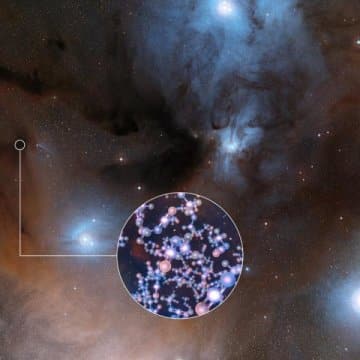Researchers at the Alma Telescope of the European Southern Observatory (ESO) in Chile observed stars like the Sun at a very early stage of their formation and found traces of methyl isocyanate, one of the chemical building blocks of life.

Alma telescope researchers of the European Southern Observatory (ESO) in Chile observed stars like the Sun at a very early stage of their formation and found traces of methyl isocyanate, one of the chemical building blocks of life. This is the first discovery of this prebiotic molecule in the vicinity of solar-type protostars of the type from which our solar system evolved. The discovery could help astronomers understand how life began on Earth.
Two groups of astronomers harnessed the Alma Atacama Large Millimeter/submillimeter Array telescopes in Chile to detect the organic molecule in the methyl isocyanate complex in the multiple star system IRAS 16293-2422. One group is led by Rafael Martin-Domenz from the Madrid Observatory and the other is led by and the other by Nils Liegetrink at the Leiden Observatory in the Netherlands and Audrey Kootens from University College London.
This star system seems to continue to provide interesting findings. After the discovery of sugars, we now also found methyl isocyanate in it, a substance from a family of organic molecules consisting of the synthesis of peptides and amino acids which, in the form of proteins, are one of the biological components of life as we know it." Liguetrink and Kutens explain.
Alma's capabilities allowed the two teams to observe the molecule at several different and characteristic wavelengths across the radio spectrum. They found the unique chemical 'fingerprints' of this material in the hot, dense inner regions of the mantle of dust and gas surrounding young stars in the earliest stages of their formation. Each team identified and isolated the signatures of methyl isocyanate. They then performed chemical experiments in the laboratory and built computer models to improve our understanding of the origin of the molecule.
IRAS 16293-2422 is a very young multi-star system, about 400 light-years away from a large star-forming region called Rho Opiiuchi in the constellation Ophiuchus. Alma's new findings showed that molecules of methyl isolate gas surround each of these young stars.
Earth and the other planets in our solar system were formed from the material left over after the formation of the sun. The study of protostellar systems of the type similar to the Sun can therefore open a window into the past for astronomers and allow them to examine conditions similar to those that led to the formation of our solar system 4.5 billion years ago.
Rafael Martin-Domenach and Victor Revilla, the main authors of one of the articles, note: "We are particularly excited about the result, because these protostars are very similar to the Sun at the beginning of their lives, and these systems have suitable conditions for the formation of Earth-sized planets. Through the discovery of pre-life molecules in this study, we have now solved another piece in the puzzle of the formation of life on Earth."
Liegetrink is happy about the supporting laboratory results: "Besides discovering the molecules, we also want to understand how they were formed, and our laboratory experiments show that methyl isocyanate can indeed be produced with the help of icy particles under very cold conditions similar to those in interstellar space. This means that this molecule – and therefore the basis of peptide bonds – may indeed be present in the vicinity of the new young stars.”
More of the topic in Hayadan:
